Digital Skills and Professional Development: Skills and Plan Report
VerifiedAdded on 2022/07/28
|10
|3847
|164
Report
AI Summary
This report delves into the realm of digital skills and professional development, emphasizing the importance of these competencies in the modern workplace. It begins by exploring the advancement of business automation technology and its impact on various industries, highlighting the need for individuals to acquire relevant digital skills to remain competitive. The report then examines the digital skills necessary to demonstrate professional competence, providing examples across different sectors and modern workplaces. It includes an analysis of social media, search engine marketing, data analytics, content marketing, email marketing, mobile marketing, and programming, web, and app development. Furthermore, the report incorporates a section on self-reflection, utilizing the Gibbs cycle model to assess management and leadership skills. Finally, it presents a personal development plan designed to enhance effective management and leadership capabilities, offering a comprehensive guide for individuals seeking to improve their professional standing.
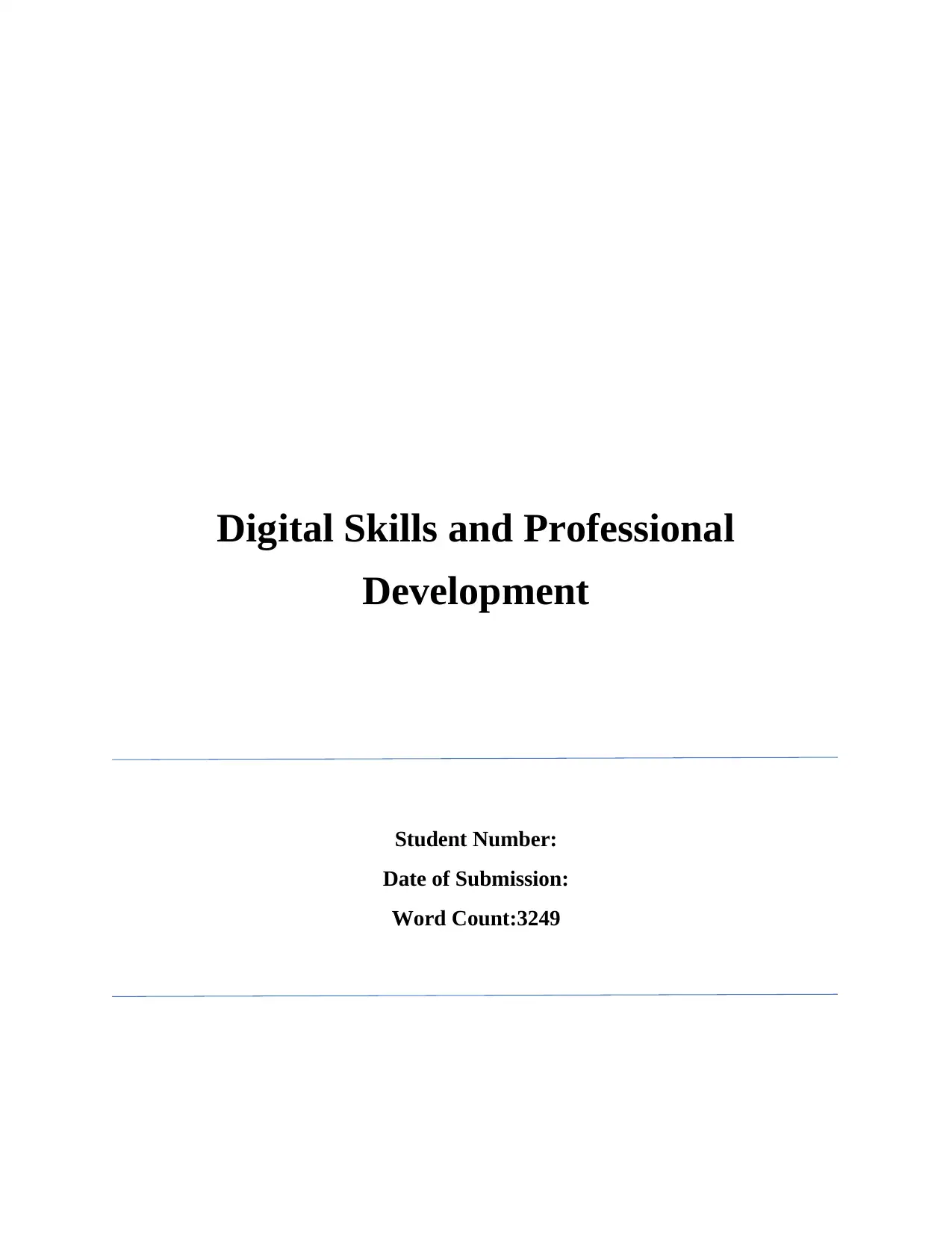
Digital Skills and Professional
Development
Student Number:
Date of Submission:
Word Count:3249
Development
Student Number:
Date of Submission:
Word Count:3249
Paraphrase This Document
Need a fresh take? Get an instant paraphrase of this document with our AI Paraphraser
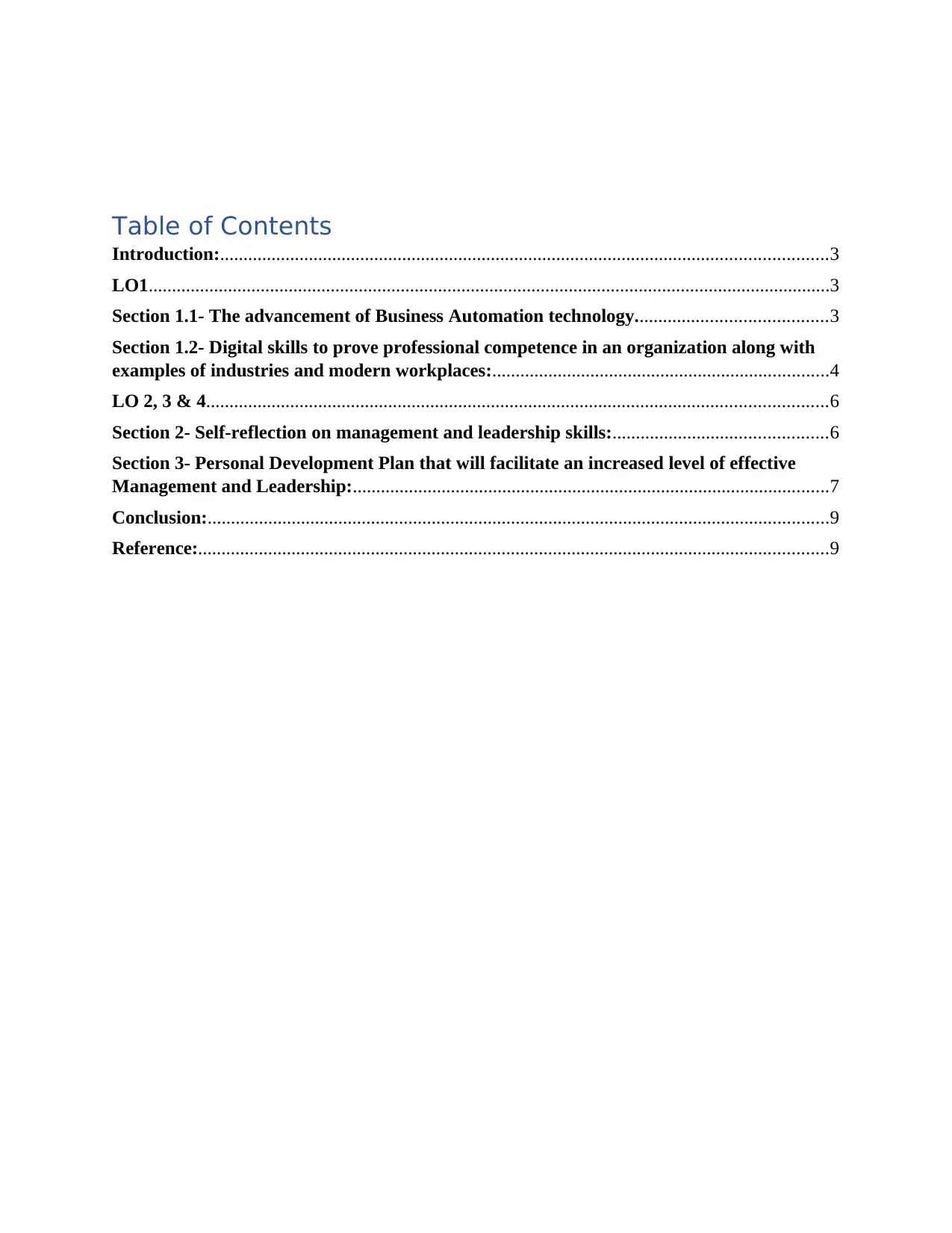
Table of Contents
Introduction:..................................................................................................................................3
LO1..................................................................................................................................................3
Section 1.1- The advancement of Business Automation technology.........................................3
Section 1.2- Digital skills to prove professional competence in an organization along with
examples of industries and modern workplaces:........................................................................4
LO 2, 3 & 4.....................................................................................................................................6
Section 2- Self-reflection on management and leadership skills:..............................................6
Section 3- Personal Development Plan that will facilitate an increased level of effective
Management and Leadership:......................................................................................................7
Conclusion:.....................................................................................................................................9
Reference:.......................................................................................................................................9
Introduction:..................................................................................................................................3
LO1..................................................................................................................................................3
Section 1.1- The advancement of Business Automation technology.........................................3
Section 1.2- Digital skills to prove professional competence in an organization along with
examples of industries and modern workplaces:........................................................................4
LO 2, 3 & 4.....................................................................................................................................6
Section 2- Self-reflection on management and leadership skills:..............................................6
Section 3- Personal Development Plan that will facilitate an increased level of effective
Management and Leadership:......................................................................................................7
Conclusion:.....................................................................................................................................9
Reference:.......................................................................................................................................9
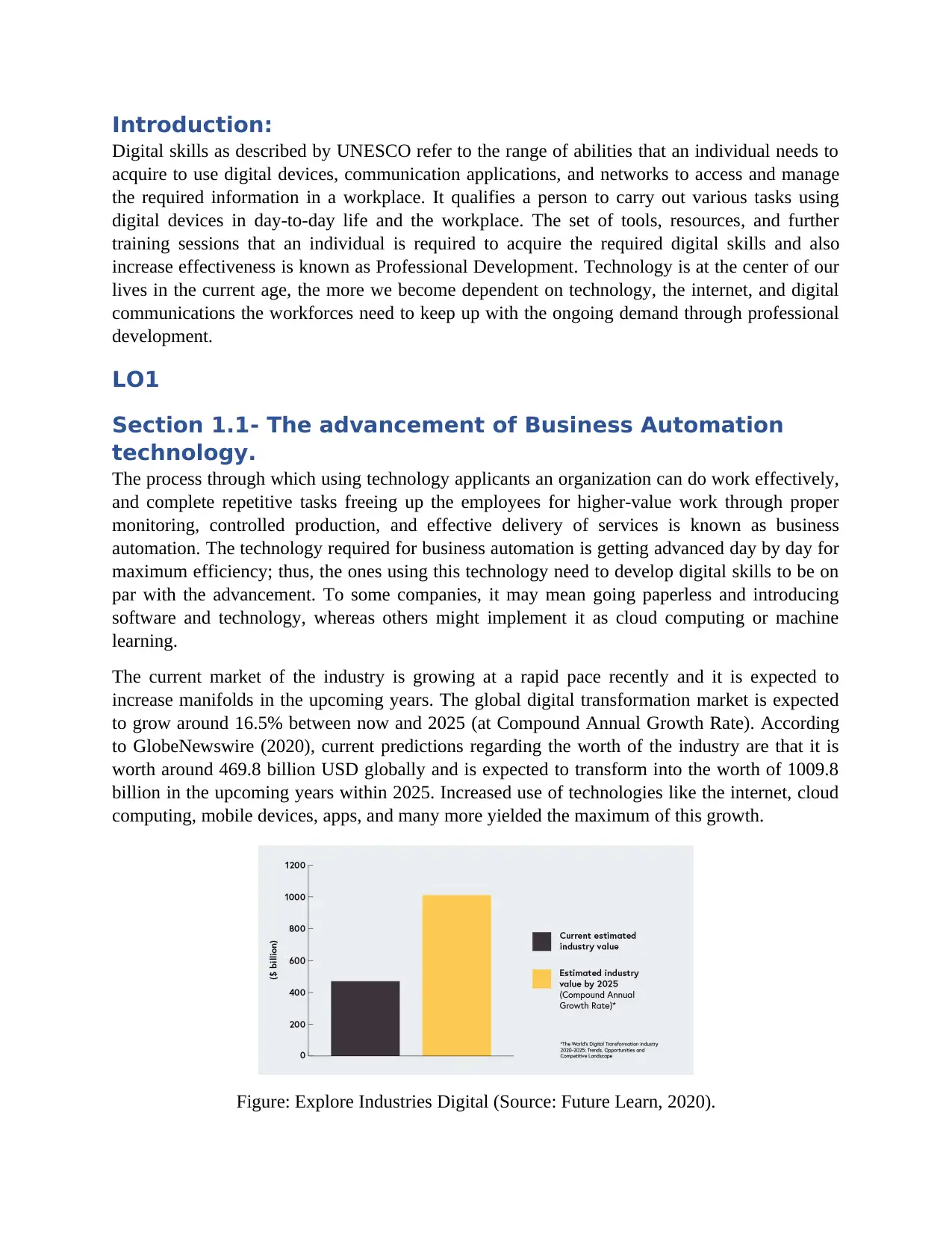
Introduction:
Digital skills as described by UNESCO refer to the range of abilities that an individual needs to
acquire to use digital devices, communication applications, and networks to access and manage
the required information in a workplace. It qualifies a person to carry out various tasks using
digital devices in day-to-day life and the workplace. The set of tools, resources, and further
training sessions that an individual is required to acquire the required digital skills and also
increase effectiveness is known as Professional Development. Technology is at the center of our
lives in the current age, the more we become dependent on technology, the internet, and digital
communications the workforces need to keep up with the ongoing demand through professional
development.
LO1
Section 1.1- The advancement of Business Automation
technology.
The process through which using technology applicants an organization can do work effectively,
and complete repetitive tasks freeing up the employees for higher-value work through proper
monitoring, controlled production, and effective delivery of services is known as business
automation. The technology required for business automation is getting advanced day by day for
maximum efficiency; thus, the ones using this technology need to develop digital skills to be on
par with the advancement. To some companies, it may mean going paperless and introducing
software and technology, whereas others might implement it as cloud computing or machine
learning.
The current market of the industry is growing at a rapid pace recently and it is expected to
increase manifolds in the upcoming years. The global digital transformation market is expected
to grow around 16.5% between now and 2025 (at Compound Annual Growth Rate). According
to GlobeNewswire (2020), current predictions regarding the worth of the industry are that it is
worth around 469.8 billion USD globally and is expected to transform into the worth of 1009.8
billion in the upcoming years within 2025. Increased use of technologies like the internet, cloud
computing, mobile devices, apps, and many more yielded the maximum of this growth.
Figure: Explore Industries Digital (Source: Future Learn, 2020).
Digital skills as described by UNESCO refer to the range of abilities that an individual needs to
acquire to use digital devices, communication applications, and networks to access and manage
the required information in a workplace. It qualifies a person to carry out various tasks using
digital devices in day-to-day life and the workplace. The set of tools, resources, and further
training sessions that an individual is required to acquire the required digital skills and also
increase effectiveness is known as Professional Development. Technology is at the center of our
lives in the current age, the more we become dependent on technology, the internet, and digital
communications the workforces need to keep up with the ongoing demand through professional
development.
LO1
Section 1.1- The advancement of Business Automation
technology.
The process through which using technology applicants an organization can do work effectively,
and complete repetitive tasks freeing up the employees for higher-value work through proper
monitoring, controlled production, and effective delivery of services is known as business
automation. The technology required for business automation is getting advanced day by day for
maximum efficiency; thus, the ones using this technology need to develop digital skills to be on
par with the advancement. To some companies, it may mean going paperless and introducing
software and technology, whereas others might implement it as cloud computing or machine
learning.
The current market of the industry is growing at a rapid pace recently and it is expected to
increase manifolds in the upcoming years. The global digital transformation market is expected
to grow around 16.5% between now and 2025 (at Compound Annual Growth Rate). According
to GlobeNewswire (2020), current predictions regarding the worth of the industry are that it is
worth around 469.8 billion USD globally and is expected to transform into the worth of 1009.8
billion in the upcoming years within 2025. Increased use of technologies like the internet, cloud
computing, mobile devices, apps, and many more yielded the maximum of this growth.
Figure: Explore Industries Digital (Source: Future Learn, 2020).
⊘ This is a preview!⊘
Do you want full access?
Subscribe today to unlock all pages.

Trusted by 1+ million students worldwide
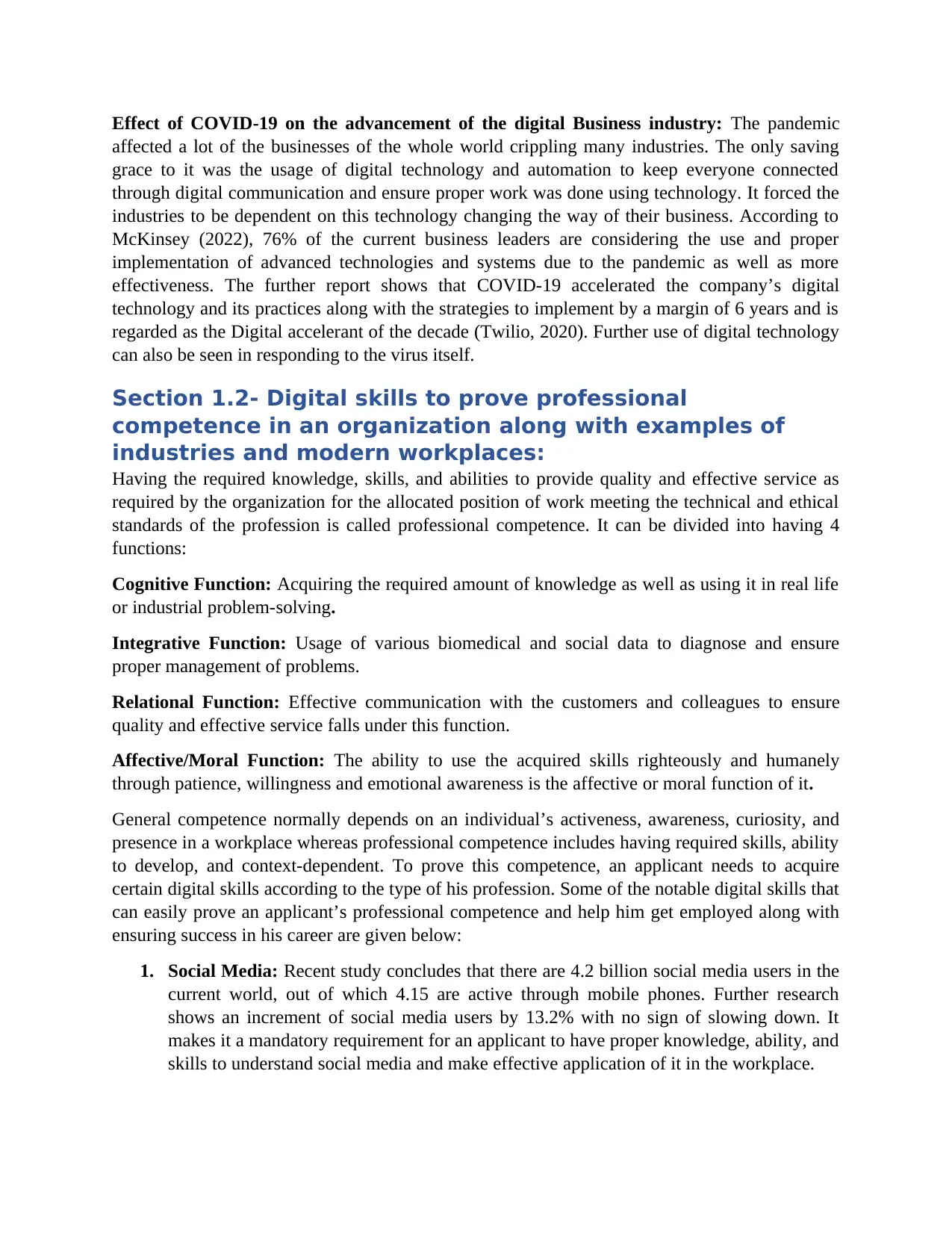
Effect of COVID-19 on the advancement of the digital Business industry: The pandemic
affected a lot of the businesses of the whole world crippling many industries. The only saving
grace to it was the usage of digital technology and automation to keep everyone connected
through digital communication and ensure proper work was done using technology. It forced the
industries to be dependent on this technology changing the way of their business. According to
McKinsey (2022), 76% of the current business leaders are considering the use and proper
implementation of advanced technologies and systems due to the pandemic as well as more
effectiveness. The further report shows that COVID-19 accelerated the company’s digital
technology and its practices along with the strategies to implement by a margin of 6 years and is
regarded as the Digital accelerant of the decade (Twilio, 2020). Further use of digital technology
can also be seen in responding to the virus itself.
Section 1.2- Digital skills to prove professional
competence in an organization along with examples of
industries and modern workplaces:
Having the required knowledge, skills, and abilities to provide quality and effective service as
required by the organization for the allocated position of work meeting the technical and ethical
standards of the profession is called professional competence. It can be divided into having 4
functions:
Cognitive Function: Acquiring the required amount of knowledge as well as using it in real life
or industrial problem-solving.
Integrative Function: Usage of various biomedical and social data to diagnose and ensure
proper management of problems.
Relational Function: Effective communication with the customers and colleagues to ensure
quality and effective service falls under this function.
Affective/Moral Function: The ability to use the acquired skills righteously and humanely
through patience, willingness and emotional awareness is the affective or moral function of it.
General competence normally depends on an individual’s activeness, awareness, curiosity, and
presence in a workplace whereas professional competence includes having required skills, ability
to develop, and context-dependent. To prove this competence, an applicant needs to acquire
certain digital skills according to the type of his profession. Some of the notable digital skills that
can easily prove an applicant’s professional competence and help him get employed along with
ensuring success in his career are given below:
1. Social Media: Recent study concludes that there are 4.2 billion social media users in the
current world, out of which 4.15 are active through mobile phones. Further research
shows an increment of social media users by 13.2% with no sign of slowing down. It
makes it a mandatory requirement for an applicant to have proper knowledge, ability, and
skills to understand social media and make effective application of it in the workplace.
affected a lot of the businesses of the whole world crippling many industries. The only saving
grace to it was the usage of digital technology and automation to keep everyone connected
through digital communication and ensure proper work was done using technology. It forced the
industries to be dependent on this technology changing the way of their business. According to
McKinsey (2022), 76% of the current business leaders are considering the use and proper
implementation of advanced technologies and systems due to the pandemic as well as more
effectiveness. The further report shows that COVID-19 accelerated the company’s digital
technology and its practices along with the strategies to implement by a margin of 6 years and is
regarded as the Digital accelerant of the decade (Twilio, 2020). Further use of digital technology
can also be seen in responding to the virus itself.
Section 1.2- Digital skills to prove professional
competence in an organization along with examples of
industries and modern workplaces:
Having the required knowledge, skills, and abilities to provide quality and effective service as
required by the organization for the allocated position of work meeting the technical and ethical
standards of the profession is called professional competence. It can be divided into having 4
functions:
Cognitive Function: Acquiring the required amount of knowledge as well as using it in real life
or industrial problem-solving.
Integrative Function: Usage of various biomedical and social data to diagnose and ensure
proper management of problems.
Relational Function: Effective communication with the customers and colleagues to ensure
quality and effective service falls under this function.
Affective/Moral Function: The ability to use the acquired skills righteously and humanely
through patience, willingness and emotional awareness is the affective or moral function of it.
General competence normally depends on an individual’s activeness, awareness, curiosity, and
presence in a workplace whereas professional competence includes having required skills, ability
to develop, and context-dependent. To prove this competence, an applicant needs to acquire
certain digital skills according to the type of his profession. Some of the notable digital skills that
can easily prove an applicant’s professional competence and help him get employed along with
ensuring success in his career are given below:
1. Social Media: Recent study concludes that there are 4.2 billion social media users in the
current world, out of which 4.15 are active through mobile phones. Further research
shows an increment of social media users by 13.2% with no sign of slowing down. It
makes it a mandatory requirement for an applicant to have proper knowledge, ability, and
skills to understand social media and make effective application of it in the workplace.
Paraphrase This Document
Need a fresh take? Get an instant paraphrase of this document with our AI Paraphraser
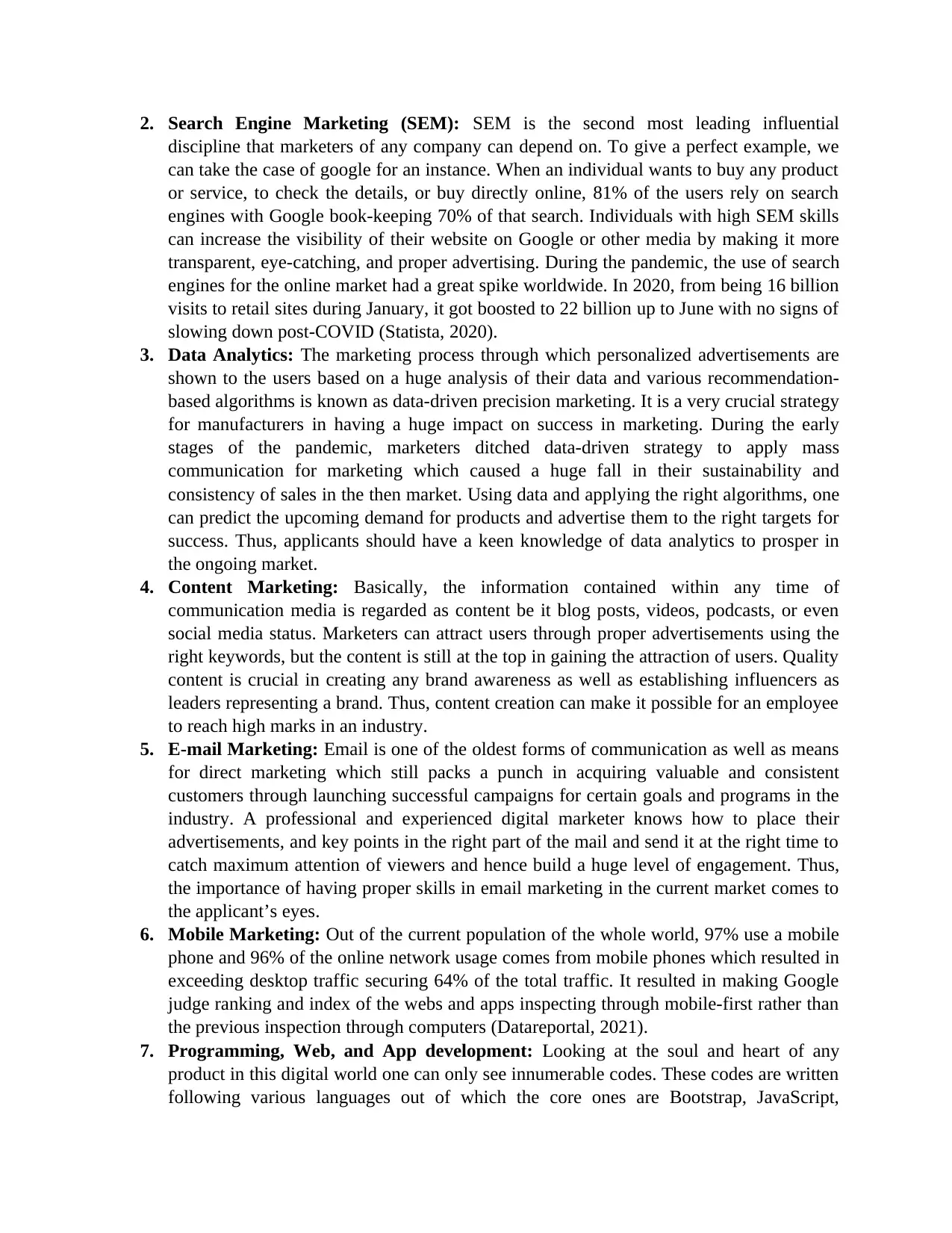
2. Search Engine Marketing (SEM): SEM is the second most leading influential
discipline that marketers of any company can depend on. To give a perfect example, we
can take the case of google for an instance. When an individual wants to buy any product
or service, to check the details, or buy directly online, 81% of the users rely on search
engines with Google book-keeping 70% of that search. Individuals with high SEM skills
can increase the visibility of their website on Google or other media by making it more
transparent, eye-catching, and proper advertising. During the pandemic, the use of search
engines for the online market had a great spike worldwide. In 2020, from being 16 billion
visits to retail sites during January, it got boosted to 22 billion up to June with no signs of
slowing down post-COVID (Statista, 2020).
3. Data Analytics: The marketing process through which personalized advertisements are
shown to the users based on a huge analysis of their data and various recommendation-
based algorithms is known as data-driven precision marketing. It is a very crucial strategy
for manufacturers in having a huge impact on success in marketing. During the early
stages of the pandemic, marketers ditched data-driven strategy to apply mass
communication for marketing which caused a huge fall in their sustainability and
consistency of sales in the then market. Using data and applying the right algorithms, one
can predict the upcoming demand for products and advertise them to the right targets for
success. Thus, applicants should have a keen knowledge of data analytics to prosper in
the ongoing market.
4. Content Marketing: Basically, the information contained within any time of
communication media is regarded as content be it blog posts, videos, podcasts, or even
social media status. Marketers can attract users through proper advertisements using the
right keywords, but the content is still at the top in gaining the attraction of users. Quality
content is crucial in creating any brand awareness as well as establishing influencers as
leaders representing a brand. Thus, content creation can make it possible for an employee
to reach high marks in an industry.
5. E-mail Marketing: Email is one of the oldest forms of communication as well as means
for direct marketing which still packs a punch in acquiring valuable and consistent
customers through launching successful campaigns for certain goals and programs in the
industry. A professional and experienced digital marketer knows how to place their
advertisements, and key points in the right part of the mail and send it at the right time to
catch maximum attention of viewers and hence build a huge level of engagement. Thus,
the importance of having proper skills in email marketing in the current market comes to
the applicant’s eyes.
6. Mobile Marketing: Out of the current population of the whole world, 97% use a mobile
phone and 96% of the online network usage comes from mobile phones which resulted in
exceeding desktop traffic securing 64% of the total traffic. It resulted in making Google
judge ranking and index of the webs and apps inspecting through mobile-first rather than
the previous inspection through computers (Datareportal, 2021).
7. Programming, Web, and App development: Looking at the soul and heart of any
product in this digital world one can only see innumerable codes. These codes are written
following various languages out of which the core ones are Bootstrap, JavaScript,
discipline that marketers of any company can depend on. To give a perfect example, we
can take the case of google for an instance. When an individual wants to buy any product
or service, to check the details, or buy directly online, 81% of the users rely on search
engines with Google book-keeping 70% of that search. Individuals with high SEM skills
can increase the visibility of their website on Google or other media by making it more
transparent, eye-catching, and proper advertising. During the pandemic, the use of search
engines for the online market had a great spike worldwide. In 2020, from being 16 billion
visits to retail sites during January, it got boosted to 22 billion up to June with no signs of
slowing down post-COVID (Statista, 2020).
3. Data Analytics: The marketing process through which personalized advertisements are
shown to the users based on a huge analysis of their data and various recommendation-
based algorithms is known as data-driven precision marketing. It is a very crucial strategy
for manufacturers in having a huge impact on success in marketing. During the early
stages of the pandemic, marketers ditched data-driven strategy to apply mass
communication for marketing which caused a huge fall in their sustainability and
consistency of sales in the then market. Using data and applying the right algorithms, one
can predict the upcoming demand for products and advertise them to the right targets for
success. Thus, applicants should have a keen knowledge of data analytics to prosper in
the ongoing market.
4. Content Marketing: Basically, the information contained within any time of
communication media is regarded as content be it blog posts, videos, podcasts, or even
social media status. Marketers can attract users through proper advertisements using the
right keywords, but the content is still at the top in gaining the attraction of users. Quality
content is crucial in creating any brand awareness as well as establishing influencers as
leaders representing a brand. Thus, content creation can make it possible for an employee
to reach high marks in an industry.
5. E-mail Marketing: Email is one of the oldest forms of communication as well as means
for direct marketing which still packs a punch in acquiring valuable and consistent
customers through launching successful campaigns for certain goals and programs in the
industry. A professional and experienced digital marketer knows how to place their
advertisements, and key points in the right part of the mail and send it at the right time to
catch maximum attention of viewers and hence build a huge level of engagement. Thus,
the importance of having proper skills in email marketing in the current market comes to
the applicant’s eyes.
6. Mobile Marketing: Out of the current population of the whole world, 97% use a mobile
phone and 96% of the online network usage comes from mobile phones which resulted in
exceeding desktop traffic securing 64% of the total traffic. It resulted in making Google
judge ranking and index of the webs and apps inspecting through mobile-first rather than
the previous inspection through computers (Datareportal, 2021).
7. Programming, Web, and App development: Looking at the soul and heart of any
product in this digital world one can only see innumerable codes. These codes are written
following various languages out of which the core ones are Bootstrap, JavaScript,
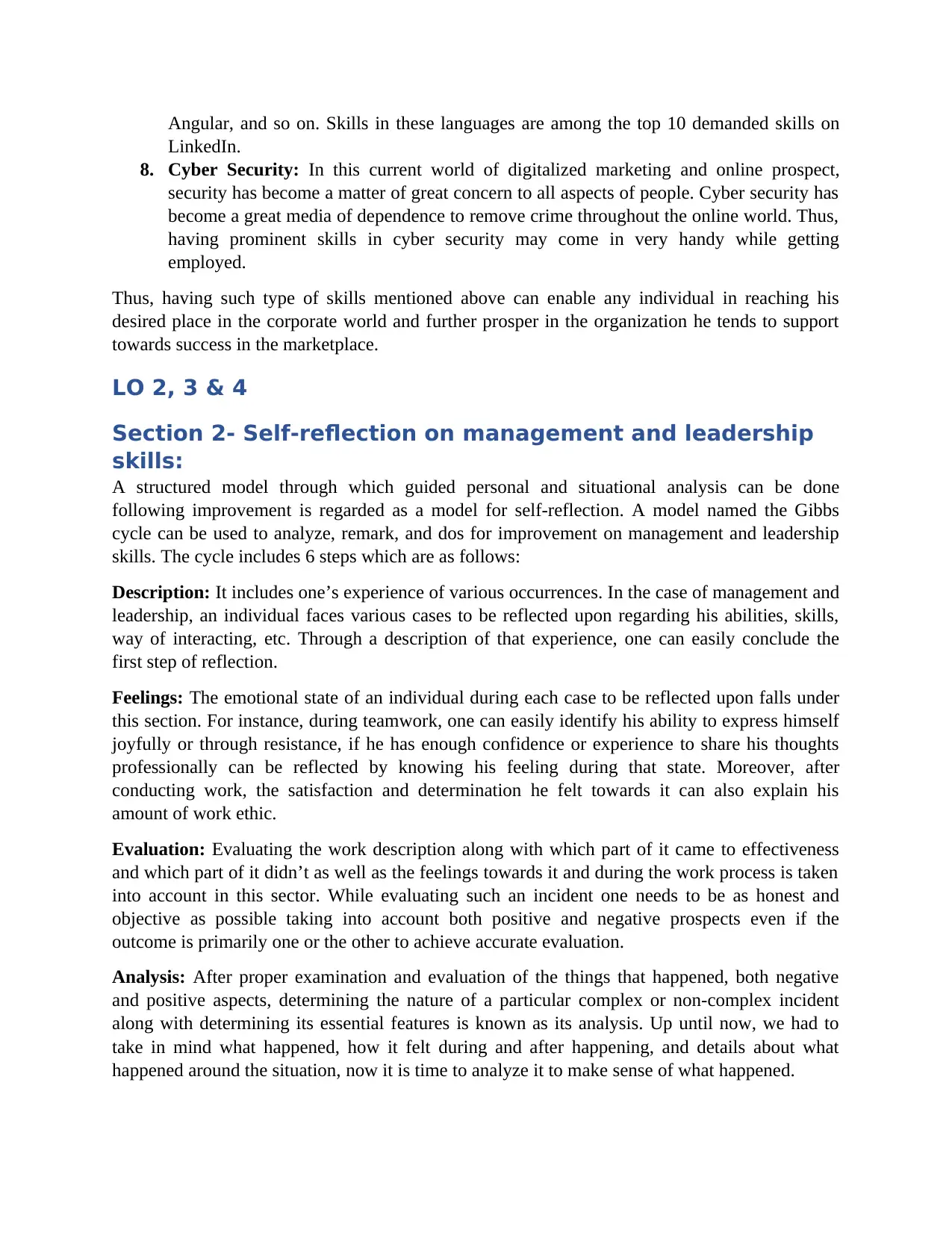
Angular, and so on. Skills in these languages are among the top 10 demanded skills on
LinkedIn.
8. Cyber Security: In this current world of digitalized marketing and online prospect,
security has become a matter of great concern to all aspects of people. Cyber security has
become a great media of dependence to remove crime throughout the online world. Thus,
having prominent skills in cyber security may come in very handy while getting
employed.
Thus, having such type of skills mentioned above can enable any individual in reaching his
desired place in the corporate world and further prosper in the organization he tends to support
towards success in the marketplace.
LO 2, 3 & 4
Section 2- Self-reflection on management and leadership
skills:
A structured model through which guided personal and situational analysis can be done
following improvement is regarded as a model for self-reflection. A model named the Gibbs
cycle can be used to analyze, remark, and dos for improvement on management and leadership
skills. The cycle includes 6 steps which are as follows:
Description: It includes one’s experience of various occurrences. In the case of management and
leadership, an individual faces various cases to be reflected upon regarding his abilities, skills,
way of interacting, etc. Through a description of that experience, one can easily conclude the
first step of reflection.
Feelings: The emotional state of an individual during each case to be reflected upon falls under
this section. For instance, during teamwork, one can easily identify his ability to express himself
joyfully or through resistance, if he has enough confidence or experience to share his thoughts
professionally can be reflected by knowing his feeling during that state. Moreover, after
conducting work, the satisfaction and determination he felt towards it can also explain his
amount of work ethic.
Evaluation: Evaluating the work description along with which part of it came to effectiveness
and which part of it didn’t as well as the feelings towards it and during the work process is taken
into account in this sector. While evaluating such an incident one needs to be as honest and
objective as possible taking into account both positive and negative prospects even if the
outcome is primarily one or the other to achieve accurate evaluation.
Analysis: After proper examination and evaluation of the things that happened, both negative
and positive aspects, determining the nature of a particular complex or non-complex incident
along with determining its essential features is known as its analysis. Up until now, we had to
take in mind what happened, how it felt during and after happening, and details about what
happened around the situation, now it is time to analyze it to make sense of what happened.
LinkedIn.
8. Cyber Security: In this current world of digitalized marketing and online prospect,
security has become a matter of great concern to all aspects of people. Cyber security has
become a great media of dependence to remove crime throughout the online world. Thus,
having prominent skills in cyber security may come in very handy while getting
employed.
Thus, having such type of skills mentioned above can enable any individual in reaching his
desired place in the corporate world and further prosper in the organization he tends to support
towards success in the marketplace.
LO 2, 3 & 4
Section 2- Self-reflection on management and leadership
skills:
A structured model through which guided personal and situational analysis can be done
following improvement is regarded as a model for self-reflection. A model named the Gibbs
cycle can be used to analyze, remark, and dos for improvement on management and leadership
skills. The cycle includes 6 steps which are as follows:
Description: It includes one’s experience of various occurrences. In the case of management and
leadership, an individual faces various cases to be reflected upon regarding his abilities, skills,
way of interacting, etc. Through a description of that experience, one can easily conclude the
first step of reflection.
Feelings: The emotional state of an individual during each case to be reflected upon falls under
this section. For instance, during teamwork, one can easily identify his ability to express himself
joyfully or through resistance, if he has enough confidence or experience to share his thoughts
professionally can be reflected by knowing his feeling during that state. Moreover, after
conducting work, the satisfaction and determination he felt towards it can also explain his
amount of work ethic.
Evaluation: Evaluating the work description along with which part of it came to effectiveness
and which part of it didn’t as well as the feelings towards it and during the work process is taken
into account in this sector. While evaluating such an incident one needs to be as honest and
objective as possible taking into account both positive and negative prospects even if the
outcome is primarily one or the other to achieve accurate evaluation.
Analysis: After proper examination and evaluation of the things that happened, both negative
and positive aspects, determining the nature of a particular complex or non-complex incident
along with determining its essential features is known as its analysis. Up until now, we had to
take in mind what happened, how it felt during and after happening, and details about what
happened around the situation, now it is time to analyze it to make sense of what happened.
⊘ This is a preview!⊘
Do you want full access?
Subscribe today to unlock all pages.

Trusted by 1+ million students worldwide
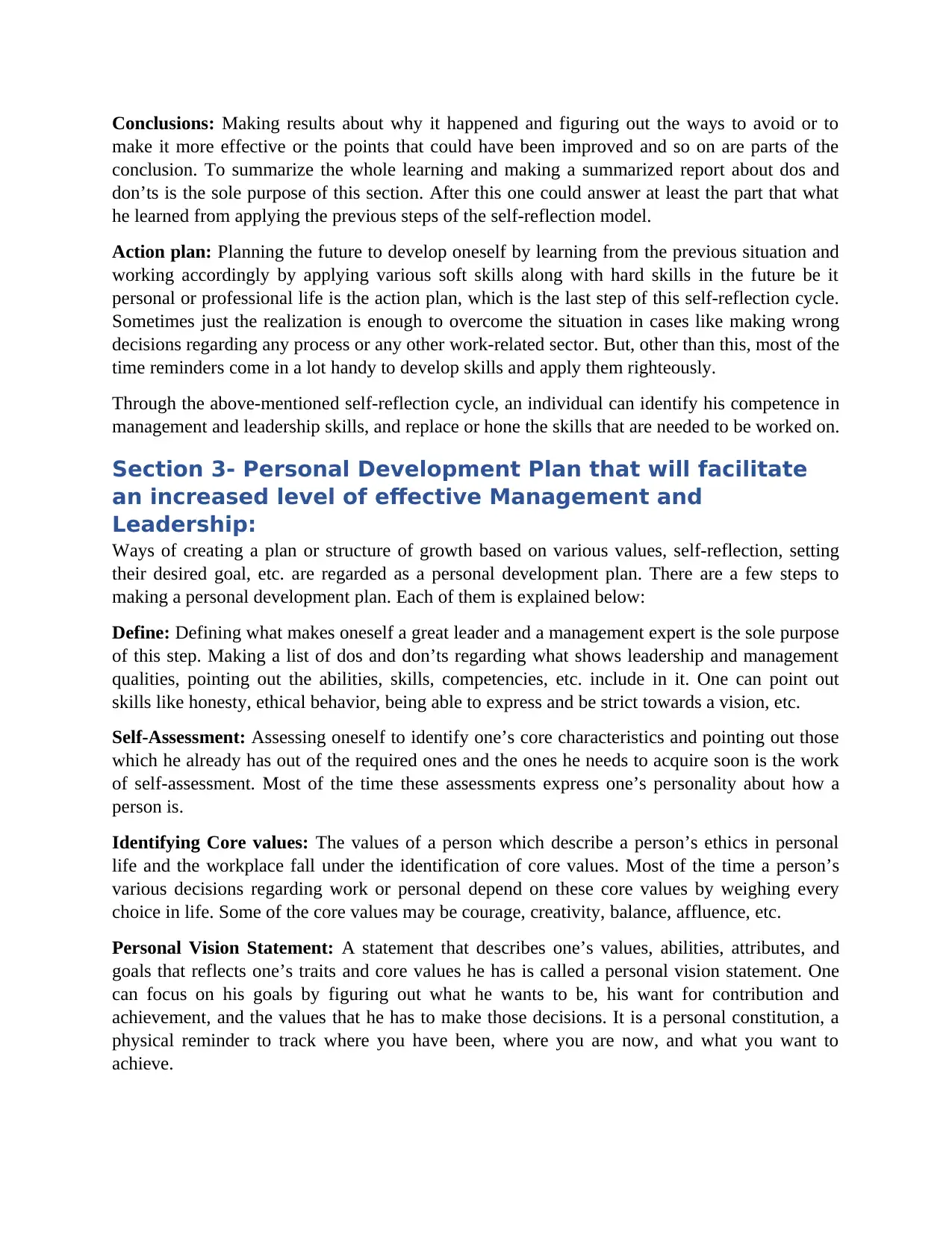
Conclusions: Making results about why it happened and figuring out the ways to avoid or to
make it more effective or the points that could have been improved and so on are parts of the
conclusion. To summarize the whole learning and making a summarized report about dos and
don’ts is the sole purpose of this section. After this one could answer at least the part that what
he learned from applying the previous steps of the self-reflection model.
Action plan: Planning the future to develop oneself by learning from the previous situation and
working accordingly by applying various soft skills along with hard skills in the future be it
personal or professional life is the action plan, which is the last step of this self-reflection cycle.
Sometimes just the realization is enough to overcome the situation in cases like making wrong
decisions regarding any process or any other work-related sector. But, other than this, most of the
time reminders come in a lot handy to develop skills and apply them righteously.
Through the above-mentioned self-reflection cycle, an individual can identify his competence in
management and leadership skills, and replace or hone the skills that are needed to be worked on.
Section 3- Personal Development Plan that will facilitate
an increased level of effective Management and
Leadership:
Ways of creating a plan or structure of growth based on various values, self-reflection, setting
their desired goal, etc. are regarded as a personal development plan. There are a few steps to
making a personal development plan. Each of them is explained below:
Define: Defining what makes oneself a great leader and a management expert is the sole purpose
of this step. Making a list of dos and don’ts regarding what shows leadership and management
qualities, pointing out the abilities, skills, competencies, etc. include in it. One can point out
skills like honesty, ethical behavior, being able to express and be strict towards a vision, etc.
Self-Assessment: Assessing oneself to identify one’s core characteristics and pointing out those
which he already has out of the required ones and the ones he needs to acquire soon is the work
of self-assessment. Most of the time these assessments express one’s personality about how a
person is.
Identifying Core values: The values of a person which describe a person’s ethics in personal
life and the workplace fall under the identification of core values. Most of the time a person’s
various decisions regarding work or personal depend on these core values by weighing every
choice in life. Some of the core values may be courage, creativity, balance, affluence, etc.
Personal Vision Statement: A statement that describes one’s values, abilities, attributes, and
goals that reflects one’s traits and core values he has is called a personal vision statement. One
can focus on his goals by figuring out what he wants to be, his want for contribution and
achievement, and the values that he has to make those decisions. It is a personal constitution, a
physical reminder to track where you have been, where you are now, and what you want to
achieve.
make it more effective or the points that could have been improved and so on are parts of the
conclusion. To summarize the whole learning and making a summarized report about dos and
don’ts is the sole purpose of this section. After this one could answer at least the part that what
he learned from applying the previous steps of the self-reflection model.
Action plan: Planning the future to develop oneself by learning from the previous situation and
working accordingly by applying various soft skills along with hard skills in the future be it
personal or professional life is the action plan, which is the last step of this self-reflection cycle.
Sometimes just the realization is enough to overcome the situation in cases like making wrong
decisions regarding any process or any other work-related sector. But, other than this, most of the
time reminders come in a lot handy to develop skills and apply them righteously.
Through the above-mentioned self-reflection cycle, an individual can identify his competence in
management and leadership skills, and replace or hone the skills that are needed to be worked on.
Section 3- Personal Development Plan that will facilitate
an increased level of effective Management and
Leadership:
Ways of creating a plan or structure of growth based on various values, self-reflection, setting
their desired goal, etc. are regarded as a personal development plan. There are a few steps to
making a personal development plan. Each of them is explained below:
Define: Defining what makes oneself a great leader and a management expert is the sole purpose
of this step. Making a list of dos and don’ts regarding what shows leadership and management
qualities, pointing out the abilities, skills, competencies, etc. include in it. One can point out
skills like honesty, ethical behavior, being able to express and be strict towards a vision, etc.
Self-Assessment: Assessing oneself to identify one’s core characteristics and pointing out those
which he already has out of the required ones and the ones he needs to acquire soon is the work
of self-assessment. Most of the time these assessments express one’s personality about how a
person is.
Identifying Core values: The values of a person which describe a person’s ethics in personal
life and the workplace fall under the identification of core values. Most of the time a person’s
various decisions regarding work or personal depend on these core values by weighing every
choice in life. Some of the core values may be courage, creativity, balance, affluence, etc.
Personal Vision Statement: A statement that describes one’s values, abilities, attributes, and
goals that reflects one’s traits and core values he has is called a personal vision statement. One
can focus on his goals by figuring out what he wants to be, his want for contribution and
achievement, and the values that he has to make those decisions. It is a personal constitution, a
physical reminder to track where you have been, where you are now, and what you want to
achieve.
Paraphrase This Document
Need a fresh take? Get an instant paraphrase of this document with our AI Paraphraser
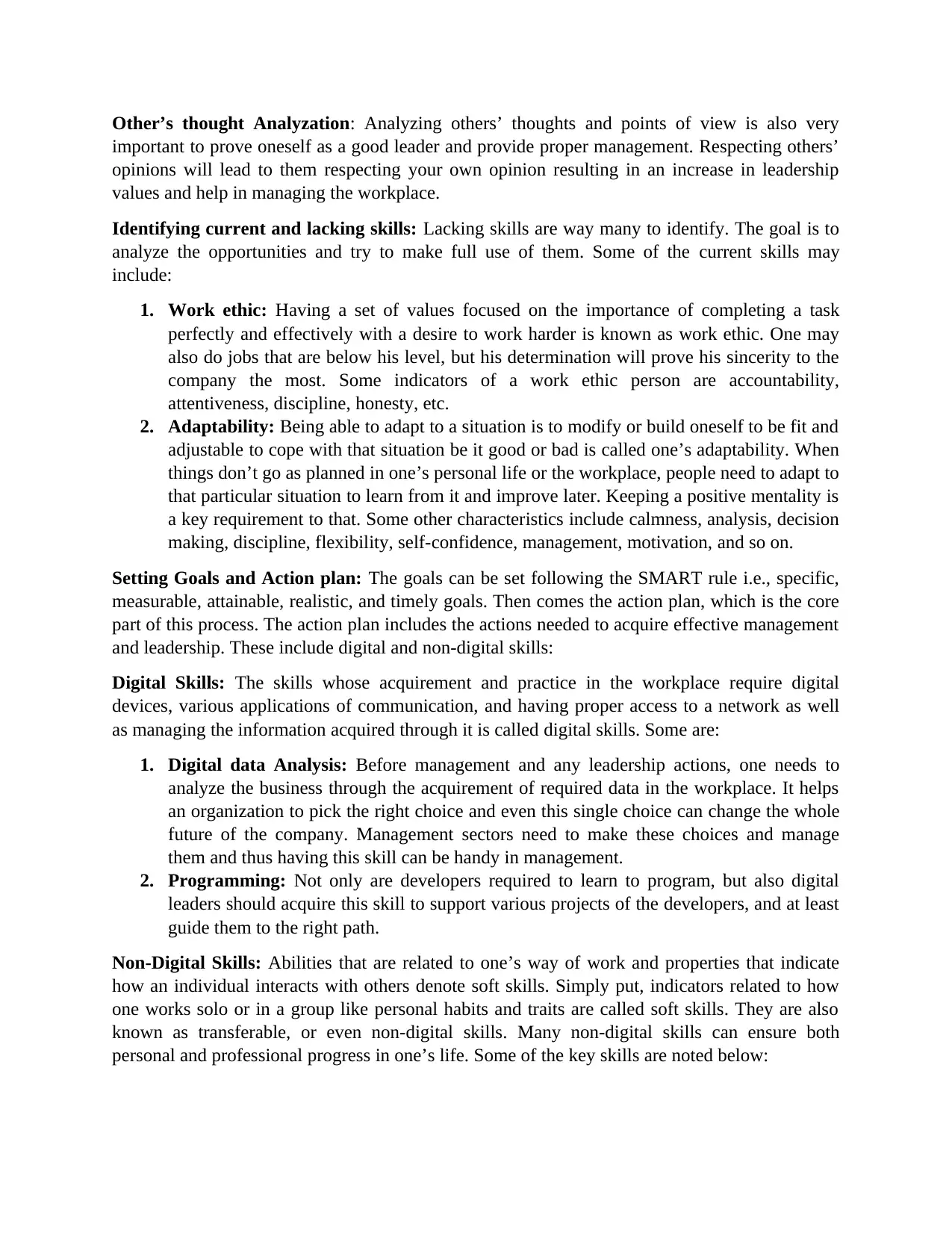
Other’s thought Analyzation: Analyzing others’ thoughts and points of view is also very
important to prove oneself as a good leader and provide proper management. Respecting others’
opinions will lead to them respecting your own opinion resulting in an increase in leadership
values and help in managing the workplace.
Identifying current and lacking skills: Lacking skills are way many to identify. The goal is to
analyze the opportunities and try to make full use of them. Some of the current skills may
include:
1. Work ethic: Having a set of values focused on the importance of completing a task
perfectly and effectively with a desire to work harder is known as work ethic. One may
also do jobs that are below his level, but his determination will prove his sincerity to the
company the most. Some indicators of a work ethic person are accountability,
attentiveness, discipline, honesty, etc.
2. Adaptability: Being able to adapt to a situation is to modify or build oneself to be fit and
adjustable to cope with that situation be it good or bad is called one’s adaptability. When
things don’t go as planned in one’s personal life or the workplace, people need to adapt to
that particular situation to learn from it and improve later. Keeping a positive mentality is
a key requirement to that. Some other characteristics include calmness, analysis, decision
making, discipline, flexibility, self-confidence, management, motivation, and so on.
Setting Goals and Action plan: The goals can be set following the SMART rule i.e., specific,
measurable, attainable, realistic, and timely goals. Then comes the action plan, which is the core
part of this process. The action plan includes the actions needed to acquire effective management
and leadership. These include digital and non-digital skills:
Digital Skills: The skills whose acquirement and practice in the workplace require digital
devices, various applications of communication, and having proper access to a network as well
as managing the information acquired through it is called digital skills. Some are:
1. Digital data Analysis: Before management and any leadership actions, one needs to
analyze the business through the acquirement of required data in the workplace. It helps
an organization to pick the right choice and even this single choice can change the whole
future of the company. Management sectors need to make these choices and manage
them and thus having this skill can be handy in management.
2. Programming: Not only are developers required to learn to program, but also digital
leaders should acquire this skill to support various projects of the developers, and at least
guide them to the right path.
Non-Digital Skills: Abilities that are related to one’s way of work and properties that indicate
how an individual interacts with others denote soft skills. Simply put, indicators related to how
one works solo or in a group like personal habits and traits are called soft skills. They are also
known as transferable, or even non-digital skills. Many non-digital skills can ensure both
personal and professional progress in one’s life. Some of the key skills are noted below:
important to prove oneself as a good leader and provide proper management. Respecting others’
opinions will lead to them respecting your own opinion resulting in an increase in leadership
values and help in managing the workplace.
Identifying current and lacking skills: Lacking skills are way many to identify. The goal is to
analyze the opportunities and try to make full use of them. Some of the current skills may
include:
1. Work ethic: Having a set of values focused on the importance of completing a task
perfectly and effectively with a desire to work harder is known as work ethic. One may
also do jobs that are below his level, but his determination will prove his sincerity to the
company the most. Some indicators of a work ethic person are accountability,
attentiveness, discipline, honesty, etc.
2. Adaptability: Being able to adapt to a situation is to modify or build oneself to be fit and
adjustable to cope with that situation be it good or bad is called one’s adaptability. When
things don’t go as planned in one’s personal life or the workplace, people need to adapt to
that particular situation to learn from it and improve later. Keeping a positive mentality is
a key requirement to that. Some other characteristics include calmness, analysis, decision
making, discipline, flexibility, self-confidence, management, motivation, and so on.
Setting Goals and Action plan: The goals can be set following the SMART rule i.e., specific,
measurable, attainable, realistic, and timely goals. Then comes the action plan, which is the core
part of this process. The action plan includes the actions needed to acquire effective management
and leadership. These include digital and non-digital skills:
Digital Skills: The skills whose acquirement and practice in the workplace require digital
devices, various applications of communication, and having proper access to a network as well
as managing the information acquired through it is called digital skills. Some are:
1. Digital data Analysis: Before management and any leadership actions, one needs to
analyze the business through the acquirement of required data in the workplace. It helps
an organization to pick the right choice and even this single choice can change the whole
future of the company. Management sectors need to make these choices and manage
them and thus having this skill can be handy in management.
2. Programming: Not only are developers required to learn to program, but also digital
leaders should acquire this skill to support various projects of the developers, and at least
guide them to the right path.
Non-Digital Skills: Abilities that are related to one’s way of work and properties that indicate
how an individual interacts with others denote soft skills. Simply put, indicators related to how
one works solo or in a group like personal habits and traits are called soft skills. They are also
known as transferable, or even non-digital skills. Many non-digital skills can ensure both
personal and professional progress in one’s life. Some of the key skills are noted below:
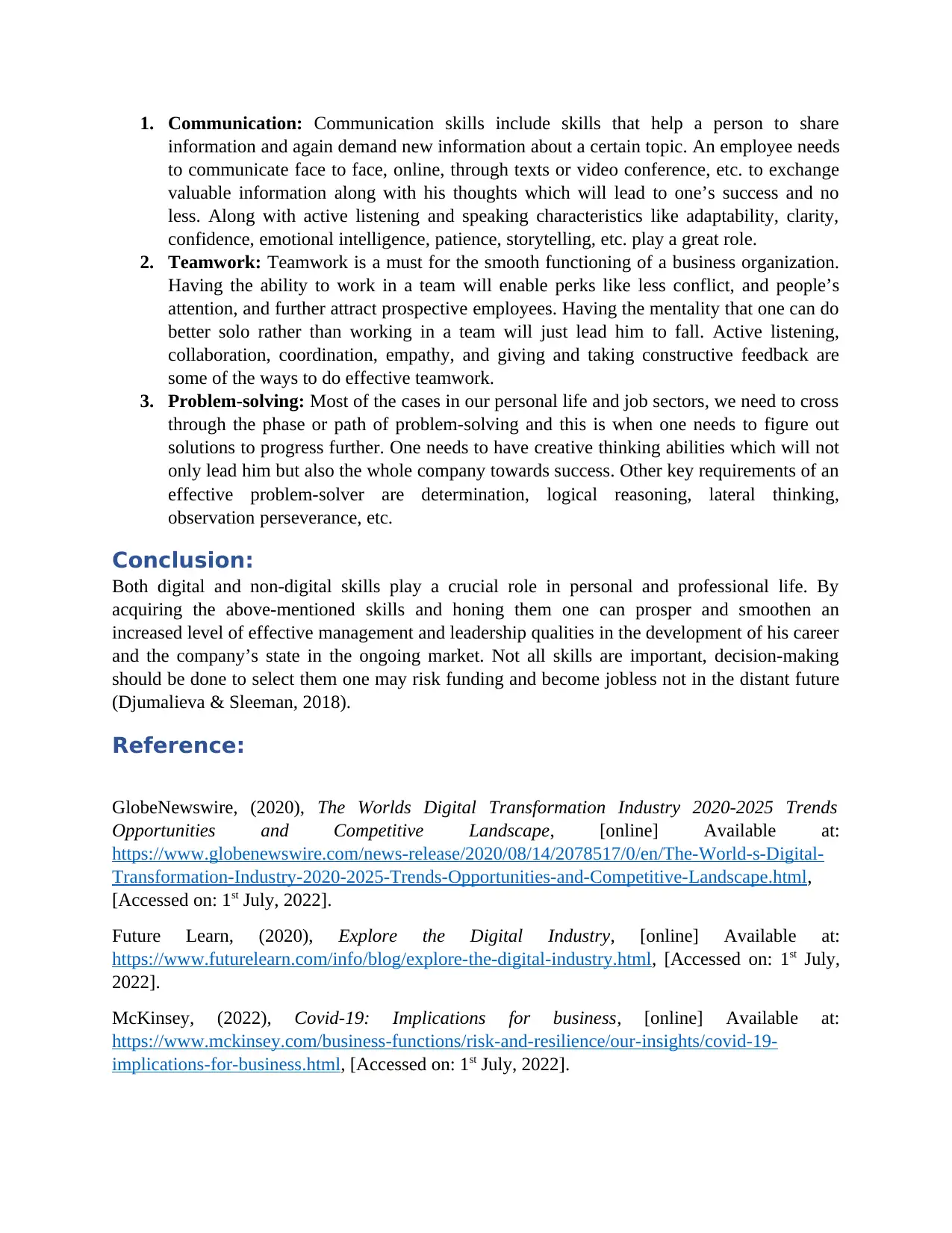
1. Communication: Communication skills include skills that help a person to share
information and again demand new information about a certain topic. An employee needs
to communicate face to face, online, through texts or video conference, etc. to exchange
valuable information along with his thoughts which will lead to one’s success and no
less. Along with active listening and speaking characteristics like adaptability, clarity,
confidence, emotional intelligence, patience, storytelling, etc. play a great role.
2. Teamwork: Teamwork is a must for the smooth functioning of a business organization.
Having the ability to work in a team will enable perks like less conflict, and people’s
attention, and further attract prospective employees. Having the mentality that one can do
better solo rather than working in a team will just lead him to fall. Active listening,
collaboration, coordination, empathy, and giving and taking constructive feedback are
some of the ways to do effective teamwork.
3. Problem-solving: Most of the cases in our personal life and job sectors, we need to cross
through the phase or path of problem-solving and this is when one needs to figure out
solutions to progress further. One needs to have creative thinking abilities which will not
only lead him but also the whole company towards success. Other key requirements of an
effective problem-solver are determination, logical reasoning, lateral thinking,
observation perseverance, etc.
Conclusion:
Both digital and non-digital skills play a crucial role in personal and professional life. By
acquiring the above-mentioned skills and honing them one can prosper and smoothen an
increased level of effective management and leadership qualities in the development of his career
and the company’s state in the ongoing market. Not all skills are important, decision-making
should be done to select them one may risk funding and become jobless not in the distant future
(Djumalieva & Sleeman, 2018).
Reference:
GlobeNewswire, (2020), The Worlds Digital Transformation Industry 2020-2025 Trends
Opportunities and Competitive Landscape, [online] Available at:
https://www.globenewswire.com/news-release/2020/08/14/2078517/0/en/The-World-s-Digital-
Transformation-Industry-2020-2025-Trends-Opportunities-and-Competitive-Landscape.html,
[Accessed on: 1st July, 2022].
Future Learn, (2020), Explore the Digital Industry, [online] Available at:
https://www.futurelearn.com/info/blog/explore-the-digital-industry.html, [Accessed on: 1st July,
2022].
McKinsey, (2022), Covid-19: Implications for business, [online] Available at:
https://www.mckinsey.com/business-functions/risk-and-resilience/our-insights/covid-19-
implications-for-business.html, [Accessed on: 1st July, 2022].
information and again demand new information about a certain topic. An employee needs
to communicate face to face, online, through texts or video conference, etc. to exchange
valuable information along with his thoughts which will lead to one’s success and no
less. Along with active listening and speaking characteristics like adaptability, clarity,
confidence, emotional intelligence, patience, storytelling, etc. play a great role.
2. Teamwork: Teamwork is a must for the smooth functioning of a business organization.
Having the ability to work in a team will enable perks like less conflict, and people’s
attention, and further attract prospective employees. Having the mentality that one can do
better solo rather than working in a team will just lead him to fall. Active listening,
collaboration, coordination, empathy, and giving and taking constructive feedback are
some of the ways to do effective teamwork.
3. Problem-solving: Most of the cases in our personal life and job sectors, we need to cross
through the phase or path of problem-solving and this is when one needs to figure out
solutions to progress further. One needs to have creative thinking abilities which will not
only lead him but also the whole company towards success. Other key requirements of an
effective problem-solver are determination, logical reasoning, lateral thinking,
observation perseverance, etc.
Conclusion:
Both digital and non-digital skills play a crucial role in personal and professional life. By
acquiring the above-mentioned skills and honing them one can prosper and smoothen an
increased level of effective management and leadership qualities in the development of his career
and the company’s state in the ongoing market. Not all skills are important, decision-making
should be done to select them one may risk funding and become jobless not in the distant future
(Djumalieva & Sleeman, 2018).
Reference:
GlobeNewswire, (2020), The Worlds Digital Transformation Industry 2020-2025 Trends
Opportunities and Competitive Landscape, [online] Available at:
https://www.globenewswire.com/news-release/2020/08/14/2078517/0/en/The-World-s-Digital-
Transformation-Industry-2020-2025-Trends-Opportunities-and-Competitive-Landscape.html,
[Accessed on: 1st July, 2022].
Future Learn, (2020), Explore the Digital Industry, [online] Available at:
https://www.futurelearn.com/info/blog/explore-the-digital-industry.html, [Accessed on: 1st July,
2022].
McKinsey, (2022), Covid-19: Implications for business, [online] Available at:
https://www.mckinsey.com/business-functions/risk-and-resilience/our-insights/covid-19-
implications-for-business.html, [Accessed on: 1st July, 2022].
⊘ This is a preview!⊘
Do you want full access?
Subscribe today to unlock all pages.

Trusted by 1+ million students worldwide
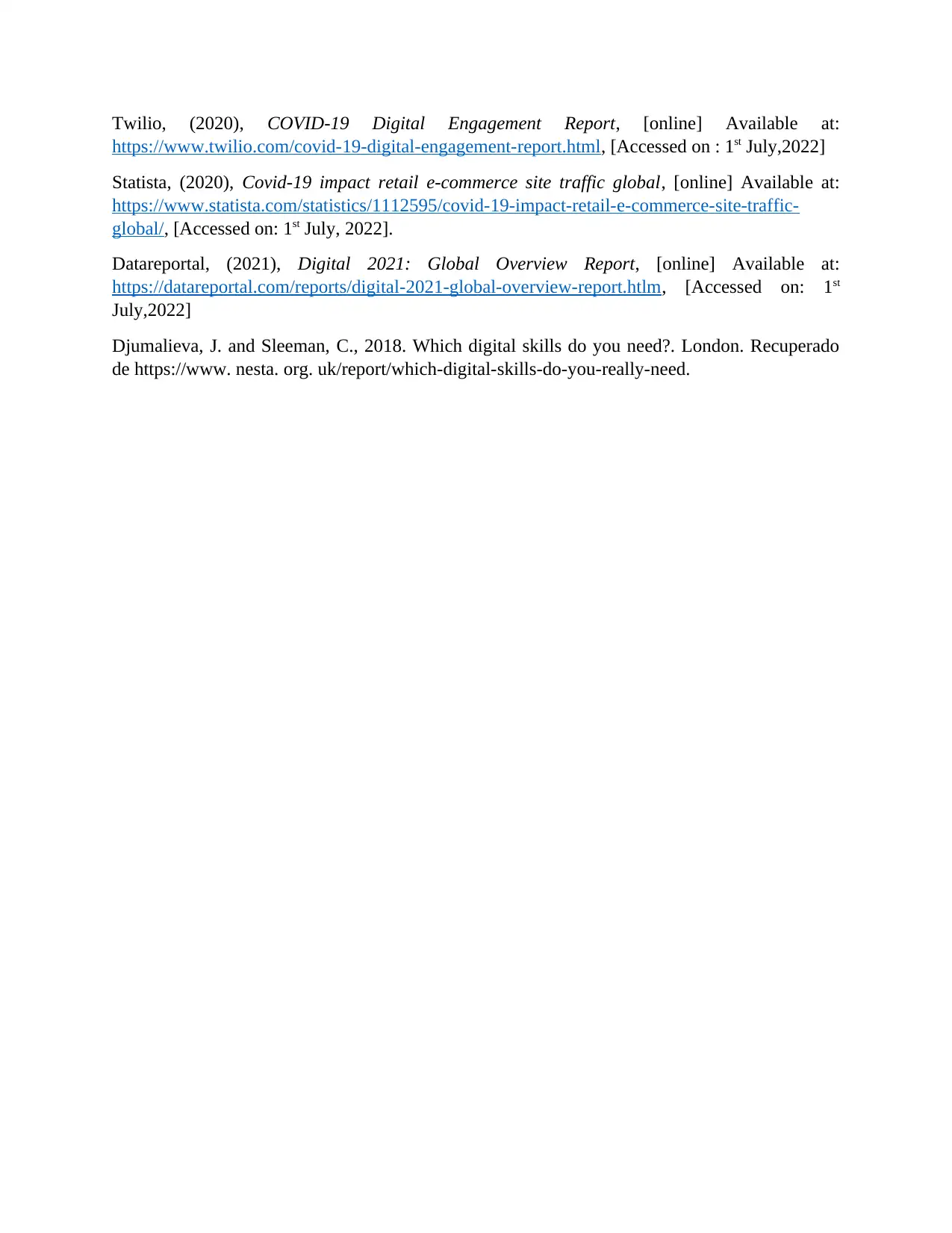
Twilio, (2020), COVID-19 Digital Engagement Report, [online] Available at:
https://www.twilio.com/covid-19-digital-engagement-report.html, [Accessed on : 1st July,2022]
Statista, (2020), Covid-19 impact retail e-commerce site traffic global, [online] Available at:
https://www.statista.com/statistics/1112595/covid-19-impact-retail-e-commerce-site-traffic-
global/, [Accessed on: 1st July, 2022].
Datareportal, (2021), Digital 2021: Global Overview Report, [online] Available at:
https://datareportal.com/reports/digital-2021-global-overview-report.htlm, [Accessed on: 1st
July,2022]
Djumalieva, J. and Sleeman, C., 2018. Which digital skills do you need?. London. Recuperado
de https://www. nesta. org. uk/report/which-digital-skills-do-you-really-need.
https://www.twilio.com/covid-19-digital-engagement-report.html, [Accessed on : 1st July,2022]
Statista, (2020), Covid-19 impact retail e-commerce site traffic global, [online] Available at:
https://www.statista.com/statistics/1112595/covid-19-impact-retail-e-commerce-site-traffic-
global/, [Accessed on: 1st July, 2022].
Datareportal, (2021), Digital 2021: Global Overview Report, [online] Available at:
https://datareportal.com/reports/digital-2021-global-overview-report.htlm, [Accessed on: 1st
July,2022]
Djumalieva, J. and Sleeman, C., 2018. Which digital skills do you need?. London. Recuperado
de https://www. nesta. org. uk/report/which-digital-skills-do-you-really-need.
1 out of 10
Related Documents
Your All-in-One AI-Powered Toolkit for Academic Success.
+13062052269
info@desklib.com
Available 24*7 on WhatsApp / Email
![[object Object]](/_next/static/media/star-bottom.7253800d.svg)
Unlock your academic potential
Copyright © 2020–2025 A2Z Services. All Rights Reserved. Developed and managed by ZUCOL.





